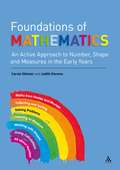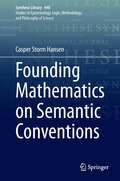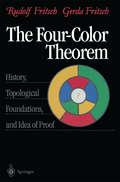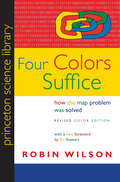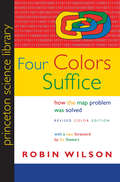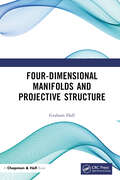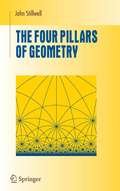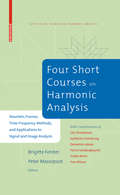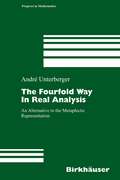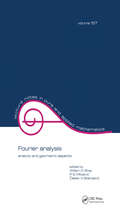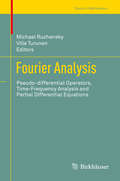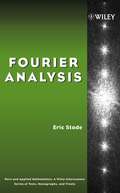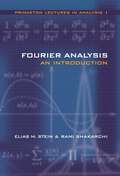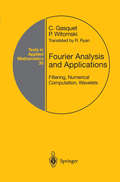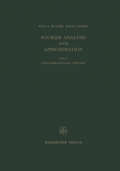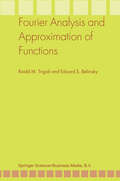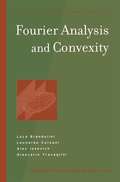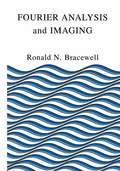- Table View
- List View
Foundations On Mathematics: An Active Approach To Number, Shape And Measures In The Early Years
by Judith Stevens Judith DancerFoundationsof Mathematicsoutlines seven strands of practice which underpin successful mathematicaldevelopment inchildren aged 3-7. Earlyyears mathematics specialists, Carole and Judith, draw on their experience ofworking with early years practitioners, including consultants and advisers,across the UK and internationally. Thebook is completely up-to-date and embeds the Revised Early Years FoundationStage throughout the book. The book brims with multi-sensory ideas thatwill trigger children's curiosity, measuring using sand mousse, hunting forburied treasure and building secret dens outdoors. There are: -activities that involve playing and exploring,-games to make learning active, and-experiences to develop creative and critical thinking. Alongsidethese practical experiences and activities are clear explanations of thereasoning behind the ideas with clear guidance on the role of the practitionerand 'Home Challenges' to promote the engagement of families. The authorsprovide straightforward advice to support the development of amathematically-enriched learning environment and ideas to help childrentransfer learning into their own child-initiated play, to build a genuine andsolid foundation for mathematics.
Founding Mathematics on Semantic Conventions (Synthese Library #446)
by Casper Storm HansenThis book presents a new nominalistic philosophy of mathematics: semantic conventionalism. Its central thesis is that mathematics should be founded on the human ability to create language – and specifically, the ability to institute conventions for the truth conditions of sentences.This philosophical stance leads to an alternative way of practicing mathematics: instead of “building” objects out of sets, a mathematician should introduce new syntactical sentence types, together with their truth conditions, as he or she develops a theory.Semantic conventionalism is justified first through criticism of Cantorian set theory, intuitionism, logicism, and predicativism; then on its own terms; and finally, exemplified by a detailed reconstruction of arithmetic and real analysis.Also included is a simple solution to the liar paradox and the other paradoxes that have traditionally been recognized as semantic. And since it is argued that mathematics is semantics, this solution also applies to Russell’s paradox and the other mathematical paradoxes of self-reference.In addition to philosophers who care about the metaphysics and epistemology of mathematics or the paradoxes of self-reference, this book should appeal to mathematicians interested in alternative approaches.
The Four-Color Theorem: History, Topological Foundations, and Idea of Proof
by Rudolf Fritsch Gerda FritschThis book discusses a famous problem that helped to define the field now known as topology: What is the minimum number of colors required to print a map so that no two adjoining countries have the same color? This problem remained unsolved until the 1950s, when it was finally cracked using a computer. This book discusses the history and mathematics of the problem, as well as the philosophical debate which ensued, regarding the validity of computer generated proofs.
Four Colors Suffice: How the Map Problem Was Solved - Revised Color Edition (Princeton Science Library #128)
by Robin WilsonOn October 23, 1852, Professor Augustus De Morgan wrote a letter to a colleague, unaware that he was launching one of the most famous mathematical conundrums in history--one that would confound thousands of puzzlers for more than a century. This is the amazing story of how the "map problem" was solved. The problem posed in the letter came from a former student: What is the least possible number of colors needed to fill in any map (real or invented) so that neighboring counties are always colored differently? This deceptively simple question was of minimal interest to cartographers, who saw little need to limit how many colors they used. But the problem set off a frenzy among professional mathematicians and amateur problem solvers, among them Lewis Carroll, an astronomer, a botanist, an obsessive golfer, the Bishop of London, a man who set his watch only once a year, a California traffic cop, and a bridegroom who spent his honeymoon coloring maps. In their pursuit of the solution, mathematicians painted maps on doughnuts and horseshoes and played with patterned soccer balls and the great rhombicuboctahedron. It would be more than one hundred years (and countless colored maps) later before the result was finally established. Even then, difficult questions remained, and the intricate solution--which involved no fewer than 1,200 hours of computer time--was greeted with as much dismay as enthusiasm. Providing a clear and elegant explanation of the problem and the proof, Robin Wilson tells how a seemingly innocuous question baffled great minds and stimulated exciting mathematics with far-flung applications. This is the entertaining story of those who failed to prove, and those who ultimately did prove, that four colors do indeed suffice to color any map. This new edition features many color illustrations. It also includes a new foreword by Ian Stewart on the importance of the map problem and how it was solved.
Four Colors Suffice: How the Map Problem Was Solved
by Robin Wilson Ian StewartOn October 23, 1852, Professor Augustus De Morgan wrote a letter to a colleague, unaware that he was launching one of the most famous mathematical conundrums in history--one that would confound thousands of puzzlers for more than a century. This is the amazing story of how the "map problem" was solved. The problem posed in the letter came from a former student: What is the least possible number of colors needed to fill in any map (real or invented) so that neighboring counties are always colored differently? This deceptively simple question was of minimal interest to cartographers, who saw little need to limit how many colors they used. But the problem set off a frenzy among professional mathematicians and amateur problem solvers, among them Lewis Carroll, an astronomer, a botanist, an obsessive golfer, the Bishop of London, a man who set his watch only once a year, a California traffic cop, and a bridegroom who spent his honeymoon coloring maps. In their pursuit of the solution, mathematicians painted maps on doughnuts and horseshoes and played with patterned soccer balls and the great rhombicuboctahedron. It would be more than one hundred years (and countless colored maps) later before the result was finally established. Even then, difficult questions remained, and the intricate solution--which involved no fewer than 1,200 hours of computer time--was greeted with as much dismay as enthusiasm. Providing a clear and elegant explanation of the problem and the proof, Robin Wilson tells how a seemingly innocuous question baffled great minds and stimulated exciting mathematics with far-flung applications. This is the entertaining story of those who failed to prove, and those who ultimately did prove, that four colors do indeed suffice to color any map. This new edition features many color illustrations. It also includes a new foreword by Ian Stewart on the importance of the map problem and how it was solved.
Four-Dimensional Manifolds and Projective Structure
by Graham HallFour-Dimensional Manifolds and Projective Structure may be considered first as an introduction to differential geometry and, in particular, to 4−dimensional manifolds, and secondly as an introduction to the study of projective structure and projective relatedness in manifolds. The initial chapters mainly cover the elementary aspects of set theory, linear algebra, topology, Euclidean geometry, manifold theory and differential geometry, including the idea of a metric and a connection on a manifold and the concept of curvature. After this, the author dives deeper into 4-dimensional manifolds and, in particular, the positive definite case for the metric. The book also covers Lorentz signature and neutral signature in detail and introduces, and makes use of, the holonomy group of such a manifold for connections associated with metrics of each of these three possible signatures. A brief interlude on some key aspects of geometrical symmetry precedes a detailed description of projective relatedness, that is, the relationship between two symmetric connections (and between their associated metrics) which give rise to the same geodesic paths. Features: Offers a detailed, straightforward discussion of the basic properties of (4-dimensional) manifolds. Introduces holonomy theory, and makes use of it, in a novel manner. Suitable for postgraduates and researchers, including master’s and PhD students.
Four-Dimensional Manifolds and Projective Structure
by Graham HallFour-Dimensional Manifolds and Projective Structure may be considered first as an introduction to differential geometry and, in particular, to 4−dimensional manifolds, and secondly as an introduction to the study of projective structure and projective relatedness in manifolds. The initial chapters mainly cover the elementary aspects of set theory, linear algebra, topology, Euclidean geometry, manifold theory and differential geometry, including the idea of a metric and a connection on a manifold and the concept of curvature. After this, the author dives deeper into 4-dimensional manifolds and, in particular, the positive definite case for the metric. The book also covers Lorentz signature and neutral signature in detail and introduces, and makes use of, the holonomy group of such a manifold for connections associated with metrics of each of these three possible signatures. A brief interlude on some key aspects of geometrical symmetry precedes a detailed description of projective relatedness, that is, the relationship between two symmetric connections (and between their associated metrics) which give rise to the same geodesic paths. Features: Offers a detailed, straightforward discussion of the basic properties of (4-dimensional) manifolds. Introduces holonomy theory, and makes use of it, in a novel manner. Suitable for postgraduates and researchers, including master’s and PhD students.
The Four Pillars of Geometry (Undergraduate Texts in Mathematics)
by John StillwellThis book is unique in that it looks at geometry from 4 different viewpoints - Euclid-style axioms, linear algebra, projective geometry, and groups and their invariants Approach makes the subject accessible to readers of all mathematical tastes, from the visual to the algebraic Abundantly supplemented with figures and exercises
Four Short Courses on Harmonic Analysis: Wavelets, Frames, Time-Frequency Methods, and Applications to Signal and Image Analysis (Applied and Numerical Harmonic Analysis)
by Ole Christensen Karlheinz Gröchenig Demetrio Labate Pierre Vandergheynst Guido Weiss Yves WiauxWritten by internationally renowned mathematicians, this state-of-the-art textbook examines four research directions in harmonic analysis and features some of the latest applications in the field. The work is the first one that combines spline theory, wavelets, frames, and time-frequency methods leading up to a construction of wavelets on manifolds other than Rn. Four Short Courses on Harmonic Analysis is intended as a graduate-level textbook for courses or seminars on harmonic analysis and its applications. The work is also an excellent reference or self-study guide for researchers and practitioners with diverse mathematical backgrounds working in different fields such as pure and applied mathematics, image and signal processing engineering, mathematical physics, and communication theory.
Four-sided pyramid and Net of a four-sided pyramid (Large Print)
by Rnib BookshareHere are two images: a four-sided pyramid, and a net of a four-sided pyramid. Cut along the fine vertical line down the centre of the A4 sheet, to make two A5 pages with an image on each. There will be a locator dot shown at the top left of each A5 page when it is the correct way up. Four-sided pyramid - The image of a four-sided pyramid is on the left of the sheet. It shows the 3D shape of a four-sided pyramid in perspective so that two of its four side faces can be found. The base of a four-sided pyramid is square and the four sides are triangular. The two faces shown in this image are distorted because of the perspective view. They have different textures (or different shades of pink in the Large Print image). The two faces have been numbered to correspond to the numbered faces on the net of a four-sided pyramid. Net of a four-sided pyramid - The net of a four-sided pyramid is on the right of the sheet. It is a flat (2D) image of its faces, arranged so that they can be folded together to make the solid 3D shape of the four-sided pyramid. To make the 3D shape, the 2D shape should be folded along the dashed lines between the faces so that all of the edges meet. A four-sided pyramids net can be made with other arrangements of the faces.
Four-sided pyramid and Net of a four-sided pyramid (UEB Contracted)
by Rnib BookshareHere are two images: a four-sided pyramid, and a net of a four-sided pyramid. Cut along the fine vertical line down the centre of the A4 sheet, to make two A5 pages with an image on each. There will be a locator dot shown at the top left of each A5 page when it is the correct way up. Four-sided pyramid - The image of a four-sided pyramid is on the left of the sheet. It shows the 3D shape of a four-sided pyramid in perspective so that two of its four side faces can be found. The base of a four-sided pyramid is square and the four sides are triangular. The two faces shown in this image are distorted because of the perspective view. They have different textures (or different shades of pink in the Large Print image). The two faces have been numbered to correspond to the numbered faces on the net of a four-sided pyramid. Net of a four-sided pyramid - The net of a four-sided pyramid is on the right of the sheet. It is a flat (2D) image of its faces, arranged so that they can be folded together to make the solid 3D shape of the four-sided pyramid. To make the 3D shape, the 2D shape should be folded along the dashed lines between the faces so that all of the edges meet. A four-sided pyramids net can be made with other arrangements of the faces.
Four-sided pyramid and Net of a four-sided pyramid (UEB Uncontracted)
by Rnib BookshareHere are two images: a four-sided pyramid, and a net of a four-sided pyramid. Cut along the fine vertical line down the centre of the A4 sheet, to make two A5 pages with an image on each. There will be a locator dot shown at the top left of each A5 page when it is the correct way up. Four-sided pyramid - The image of a four-sided pyramid is on the left of the sheet. It shows the 3D shape of a four-sided pyramid in perspective so that two of its four side faces can be found. The base of a four-sided pyramid is square and the four sides are triangular. The two faces shown in this image are distorted because of the perspective view. They have different textures (or different shades of pink in the Large Print image). The two faces have been numbered to correspond to the numbered faces on the net of a four-sided pyramid. Net of a four-sided pyramid - The net of a four-sided pyramid is on the right of the sheet. It is a flat (2D) image of its faces, arranged so that they can be folded together to make the solid 3D shape of the four-sided pyramid. To make the 3D shape, the 2D shape should be folded along the dashed lines between the faces so that all of the edges meet. A four-sided pyramids net can be made with other arrangements of the faces.
The Fourfold Way in Real Analysis: An Alternative to the Metaplectic Representation (Progress in Mathematics #250)
by André UnterbergerFourier Analysis: Analytic and Geometric Aspects
by William O. BrayProviding complete expository and research papers on the geometric and analytic aspects of Fourier analysis, this work discusses new approaches to classical problems in the theory of trigonometric series, singular integrals/pseudo-differential operators, Fourier analysis on various groups, numerical aspects of Fourier analysis and their applications, wavelets and more.
Fourier Analysis: Pseudo-differential Operators, Time-Frequency Analysis and Partial Differential Equations (Trends in Mathematics)
by Michael Ruzhansky Ville TurunenThis book is devoted to the broad field of Fourier analysis and its applications to several areas of mathematics, including problems in the theory of pseudo-differential operators, partial differential equations, and time-frequency analysis. It is based on lectures given at the international conference “Fourier Analysis and Pseudo-Differential Operators,” June 25–30, 2012, at Aalto University, Finland. This collection of 20 refereed articles is based on selected talks and presents the latest advances in the field. The conference was a satellite meeting of the 6th European Congress of Mathematics, which took place in Krakow in July 2012; it was also the 6th meeting in the series “Fourier Analysis and Partial Differential Equations.”
Fourier Analysis (Pure and Applied Mathematics: A Wiley Series of Texts, Monographs and Tracts #109)
by Eric StadeA reader-friendly, systematic introduction to Fourier analysis Rich in both theory and application, Fourier Analysis presents a unique and thorough approach to a key topic in advanced calculus. This pioneering resource tells the full story of Fourier analysis, including its history and its impact on the development of modern mathematical analysis, and also discusses essential concepts and today's applications. Written at a rigorous level, yet in an engaging style that does not dilute the material, Fourier Analysis brings two profound aspects of the discipline to the forefront: the wealth of applications of Fourier analysis in the natural sciences and the enormous impact Fourier analysis has had on the development of mathematics as a whole. Systematic and comprehensive, the book: Presents material using a cause-and-effect approach, illustrating where ideas originated and what necessitated them Includes material on wavelets, Lebesgue integration, L2 spaces, and related concepts Conveys information in a lucid, readable style, inspiring further reading and research on the subject Provides exercises at the end of each section, as well as illustrations and worked examples throughout the text Based upon the principle that theory and practice are fundamentally linked, Fourier Analysis is the ideal text and reference for students in mathematics, engineering, and physics, as well as scientists and technicians in a broad range of disciplines who use Fourier analysis in real-world situations.
Fourier Analysis: An Introduction
by Elias M. Stein Rami ShakarchiThis first volume, a three-part introduction to the subject, is intended for students with a beginning knowledge of mathematical analysis who are motivated to discover the ideas that shape Fourier analysis. It begins with the simple conviction that Fourier arrived at in the early nineteenth century when studying problems in the physical sciences--that an arbitrary function can be written as an infinite sum of the most basic trigonometric functions. The first part implements this idea in terms of notions of convergence and summability of Fourier series, while highlighting applications such as the isoperimetric inequality and equidistribution. The second part deals with the Fourier transform and its applications to classical partial differential equations and the Radon transform; a clear introduction to the subject serves to avoid technical difficulties. The book closes with Fourier theory for finite abelian groups, which is applied to prime numbers in arithmetic progression. In organizing their exposition, the authors have carefully balanced an emphasis on key conceptual insights against the need to provide the technical underpinnings of rigorous analysis. Students of mathematics, physics, engineering and other sciences will find the theory and applications covered in this volume to be of real interest. The Princeton Lectures in Analysis represents a sustained effort to introduce the core areas of mathematical analysis while also illustrating the organic unity between them. Numerous examples and applications throughout its four planned volumes, of which Fourier Analysis is the first, highlight the far-reaching consequences of certain ideas in analysis to other fields of mathematics and a variety of sciences. Stein and Shakarchi move from an introduction addressing Fourier series and integrals to in-depth considerations of complex analysis; measure and integration theory, and Hilbert spaces; and, finally, further topics such as functional analysis, distributions and elements of probability theory.
Fourier Analysis: An Introduction
by Elias M. Stein Rami ShakarchiThis first volume, a three-part introduction to the subject, is intended for students with a beginning knowledge of mathematical analysis who are motivated to discover the ideas that shape Fourier analysis. It begins with the simple conviction that Fourier arrived at in the early nineteenth century when studying problems in the physical sciences--that an arbitrary function can be written as an infinite sum of the most basic trigonometric functions. The first part implements this idea in terms of notions of convergence and summability of Fourier series, while highlighting applications such as the isoperimetric inequality and equidistribution. The second part deals with the Fourier transform and its applications to classical partial differential equations and the Radon transform; a clear introduction to the subject serves to avoid technical difficulties. The book closes with Fourier theory for finite abelian groups, which is applied to prime numbers in arithmetic progression. In organizing their exposition, the authors have carefully balanced an emphasis on key conceptual insights against the need to provide the technical underpinnings of rigorous analysis. Students of mathematics, physics, engineering and other sciences will find the theory and applications covered in this volume to be of real interest. The Princeton Lectures in Analysis represents a sustained effort to introduce the core areas of mathematical analysis while also illustrating the organic unity between them. Numerous examples and applications throughout its four planned volumes, of which Fourier Analysis is the first, highlight the far-reaching consequences of certain ideas in analysis to other fields of mathematics and a variety of sciences. Stein and Shakarchi move from an introduction addressing Fourier series and integrals to in-depth considerations of complex analysis; measure and integration theory, and Hilbert spaces; and, finally, further topics such as functional analysis, distributions and elements of probability theory.
Fourier Analysis: Analytic and Geometric Aspects
by William O. Bray; P.S. Milojević; Časlav V. StanojevićProviding complete expository and research papers on the geometric and analytic aspects of Fourier analysis, this work discusses new approaches to classical problems in the theory of trigonometric series, singular integrals/pseudo-differential operators, Fourier analysis on various groups, numerical aspects of Fourier analysis and their applications, wavelets and more.
Fourier Analysis and Applications: Filtering, Numerical Computation, Wavelets (Texts in Applied Mathematics #30)
by Claude Gasquet Patrick WitomskiThe object of this book is two-fold -- on the one hand it conveys to mathematical readers a rigorous presentation and exploration of the important applications of analysis leading to numerical calculations. On the other hand, it presents physics readers with a body of theory in which the well-known formulae find their justification. The basic study of fundamental notions, such as Lebesgue integration and theory of distribution, allow the establishment of the following areas: Fourier analysis and convolution Filters and signal analysis time-frequency analysis (gabor transforms and wavelets). The whole is rounded off with a large number of exercises as well as selected worked-out solutions.
Fourier Analysis and Applications: Filtering, Numerical Computation, Wavelets (Texts in Applied Mathematics #30)
by Claude Gasquet Patrick WitomskiFourier Analysis and Approximation: One Dimensional Theory (Lehrbücher und Monographien aus dem Gebiete der exakten Wissenschaften #1)
by P.L. Butzer Nessel TrebelsAt the international conference on 'Harmonic Analysis and Integral Transforms', conducted by one of the authors at the Mathematical Research Institute in Oberwolfach (Black Forest) in August 1965, it was felt that there was a real need for a book on Fourier analysis stressing (i) parallel treatment of Fourier series and Fourier trans forms from a transform point of view, (ii) treatment of Fourier transforms in LP(lRn)_ space not only for p = 1 and p = 2, (iii) classical solution of partial differential equations with completely rigorous proofs, (iv) theory of singular integrals of convolu tion type, (v) applications to approximation theory including saturation theory, (vi) multiplier theory, (vii) Hilbert transforms, Riesz fractional integrals, Bessel potentials, (viii) Fourier transform methods on locally compact groups. This study aims to consider these aspects, presenting a systematic treatment of Fourier analysis on the circle as well as on the infinite line, and of those areas of approximation theory which are in some way or other related thereto. A second volume is in preparation which goes beyond the one-dimensional theory presented here to cover the subject for functions of several variables. Approximately a half of this first volume deals with the theories of Fourier series and of Fourier integrals from a transform point of view.
Fourier Analysis and Approximation of Functions
by Roald M. Trigub Eduard S. BelinskyIn Fourier Analysis and Approximation of Functions basics of classical Fourier Analysis are given as well as those of approximation by polynomials, splines and entire functions of exponential type. In Chapter 1 which has an introductory nature, theorems on convergence, in that or another sense, of integral operators are given. In Chapter 2 basic properties of simple and multiple Fourier series are discussed, while in Chapter 3 those of Fourier integrals are studied. The first three chapters as well as partially Chapter 4 and classical Wiener, Bochner, Bernstein, Khintchin, and Beurling theorems in Chapter 6 might be interesting and available to all familiar with fundamentals of integration theory and elements of Complex Analysis and Operator Theory. Applied mathematicians interested in harmonic analysis and/or numerical methods based on ideas of Approximation Theory are among them. In Chapters 6-11 very recent results are sometimes given in certain directions. Many of these results have never appeared as a book or certain consistent part of a book and can be found only in periodics; looking for them in numerous journals might be quite onerous, thus this book may work as a reference source. The methods used in the book are those of classical analysis, Fourier Analysis in finite-dimensional Euclidean space Diophantine Analysis, and random choice.
Fourier Analysis and Convexity (Applied and Numerical Harmonic Analysis)
by Luca Brandolini Leonardo Colzani Alex Iosevich Giancarlo TravagliniExplores relationship between Fourier Analysis, convex geometry, and related areas; in the past, study of this relationship has led to important mathematical advances Presents new results and applications to diverse fields such as geometry, number theory, and analysis Contributors are leading experts in their respective fields Will be of interest to both pure and applied mathematicians
Fourier Analysis and Imaging
by Ronald BracewellAs Lord Kelvin said, "Fourier's theorem is not only one of the most beautiful results of modern analysis, but it may be said to furnish an indispensable instrument in the treatment of nearly every recondite question in modern physics." This has remained durable knowledge for a century, and has extended its applicability to topics as diverse as medical imaging (CT scanning), the presentation of images on screens and their digital transmission, remote sensing, geophysical exploration, and many branches of engineering. Fourier Analysis and Imaging is based on years of teaching a course on the Fourier Transform at the senior or early graduate level, as well as on Prof. Bracewell's 1995 text Two-Dimensional Imaging. It is an excellent textbook and will also be a welcome addition to the reference library of those many professionals whose daily activities involve Fourier analysis in its many guises.
